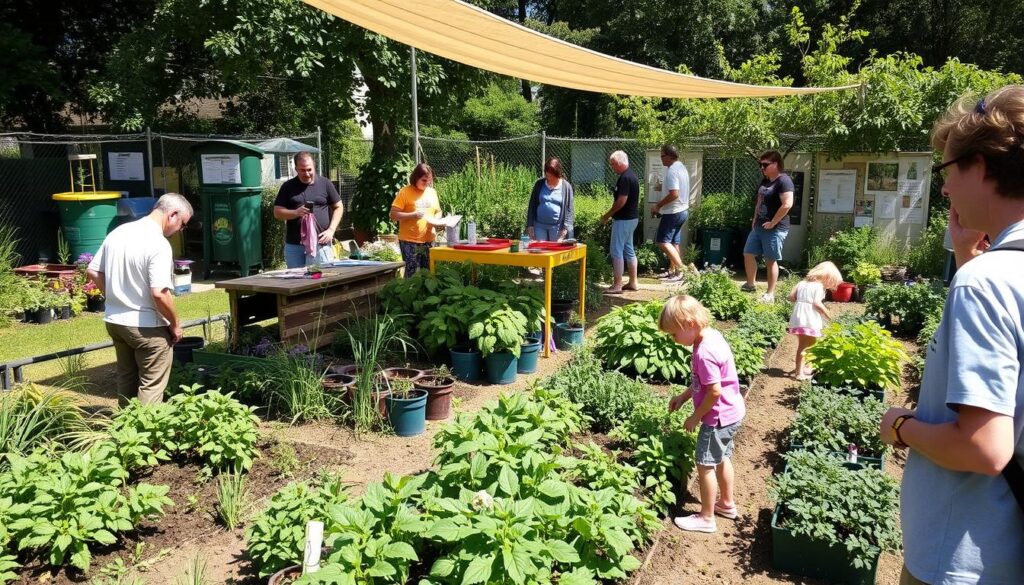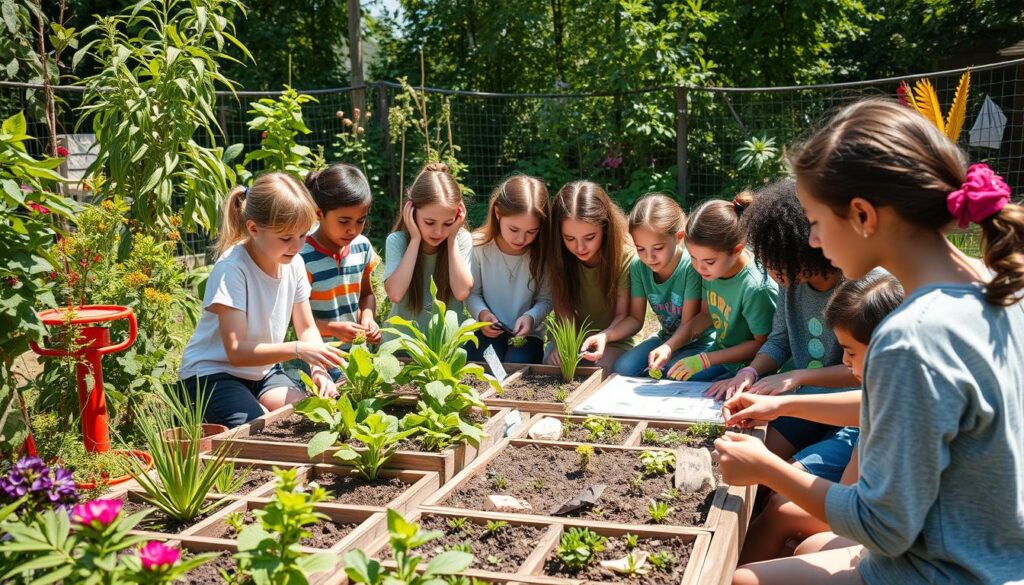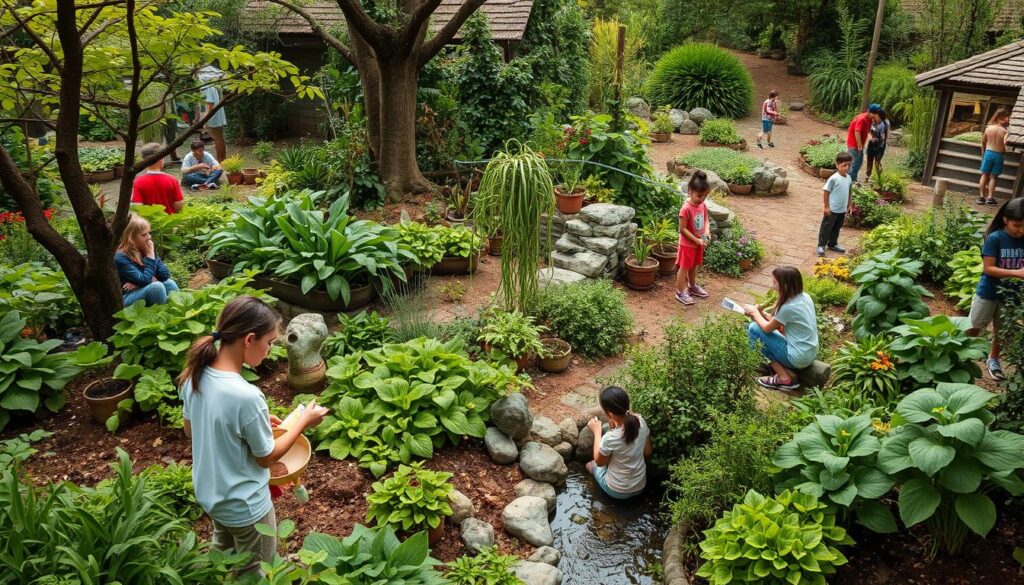Imagine if teaching permaculture could help us live more sustainably and raise a greener generation. Experts like Rosemary Morrow have shown us how permaculture can make a big difference. She’s worked in places where permaculture is most needed, showing its power in education.
Permaculture education works in many places, from cities to refugee camps. Rosemary Morrow has spent thirty years proving its worth. By using permaculture in schools, we can teach kids to care for our planet. But how do we make permaculture a part of our education system?
Key Takeaways
- Permaculture teaching methods are essential for promoting sustainable education practices.
- Permaculture education is adaptable across various contexts, including urban, rural, and refugee settings.
- Rosemary Morrow’s work and publications, such as “Earth User’s Guide to Teaching Permaculture,” provide valuable resources for teachers.
- Permaculture teaching methods have the potential to address issues arising from cascading disasters.
- Effective permaculture teaching methods can create a more holistic approach to learning and promote a better understanding of the importance of permaculture.
- Permaculture teaching methods can contribute to a more environmentally conscious society.
Understanding Permaculture: Foundations of Teaching
Permaculture is a design system that aims to make ecosystems sustainable and regenerative. To teach permaculture well, you need to know its basics. This includes key principles, ethics, and systems thinking. Using holistic learning approaches and regenerative teaching techniques helps students grasp permaculture deeply.
Permaculture’s key principles include observing nature, catching and storing energy, and using small solutions. These ideas apply in many areas, like farming and city planning. Teachers can teach students to think about systems, which is key to understanding permaculture.
By teaching permaculture with holistic learning approaches and regenerative teaching techniques, educators can help students understand it better. They can use real examples, case studies, and hands-on activities. This makes learning fun and practical.
Key Principles of Permaculture
- Observe and interact with nature
- Catch and store energy
- Use small, slow solutions
Importance of Ethical Considerations
Ethics are key in permaculture teaching. They help students feel responsible for the environment. By teaching ethics, educators can deepen students’ understanding of permaculture.
The Role of Systems Thinking
Systems thinking is vital in permaculture education. It helps students see how living systems and the environment are connected. Teachers can use regenerative teaching techniques and holistic learning approaches to teach this. It’s essential for understanding permaculture.
Learning Styles and Educational Needs
Teaching permaculture well means knowing how students learn best. It’s key to understand their different learning styles and needs. This way, teachers can make learning fun and welcoming for everyone. It’s very important in teaching about the environment and organic gardening, where doing things hands-on is essential.
Studies show that about 70% of people learn better when they see how things work in real life. This shows why hands-on learning is so important in permaculture classes. Teachers can use pictures, talks, and activities to reach all kinds of learners.

- Using visual aids to enhance learner retention
- Facilitating discussions to improve student engagement
- Providing hands-on activities to connect theory to practice
By using these methods, teachers can make learning better for everyone. This leads to happier and more successful students.
Curriculum Development for Permaculture Education
Creating a good permaculture curriculum means using hands-on training and experiential learning. This way, students get real experience and understand permaculture better. Many sources agree that these methods are key for a great curriculum.
The Permaculture Design Course (PDC) is a great example. It has at least 72 hours of learning. It teaches the basics of permaculture design. Advanced courses go deeper, focusing on project development and permaculture ethics.
Structuring a Permaculture Curriculum
Building a permaculture curriculum needs careful planning. It should cover important topics like ethics, principles, and design methods. Working with local experts and using real examples makes learning better. For example, the Permaculture Education Institute teaches thousands, focusing on hands-on learning and community involvement.
Essential Topics to Include
Key topics for a permaculture curriculum include:
- Permaculture ethics and principles
- Design methods and techniques
- Sustainable agriculture and food systems
- Ecosystem management and conservation
These topics can be taught through hands-on training and experiential learning. This can be through workshops, field trips, and community projects.
Hands-On Learning in Permaculture
Practical experience is key in permaculture education. It lets students use what they learn in real life. This way, they get a better grasp of permaculture’s principles and how to apply them.
Hands-on workshops and interactive learning make learning fun and effective. Students learn important skills like observing, thinking critically, and solving problems. These skills are crucial for working well in permaculture, whether it’s in a small garden or a big ecosystem.

- Improved retention of knowledge and skills
- Enhanced critical thinking and problem-solving abilities
- Increased confidence and motivation among learners
- Opportunities for networking and community building
Creating good workshops and having the right tools and resources is vital. By using new teaching methods and interactive learning, teachers can make learning fun and useful. This way, they meet the needs of all learners.
Integrating Technology in Permaculture Teaching
The world is getting more digital, and so is permaculture teaching. This change helps make learning more engaging and effective. By using online tools and multimedia, teachers can make learning fun and interactive for students.
Technology brings many benefits to permaculture teaching:
- It makes learning accessible to more people worldwide.
- It keeps students interested and motivated through multimedia.
- It helps students work together and share knowledge online.
By using technology, teachers can make learning better and more sustainable. This approach helps spread permaculture’s important ideas. It aims to create a greener and more sustainable future for all.
Community-Based Learning Approaches
Community-based learning is key for holistic learning approaches and regenerative teaching techniques. It involves building community gardens and organizing workshops. Students learn from each other and their community, building teamwork and support.
Research shows this method boosts motivation and grades. A study by Hmelo-Silver (2004) found it enhances critical thinking and creativity. The European Commission also highlights its value in lifelong learning, focusing on four main areas.
For more on this, check out permaculture practice. It explores the advantages of regenerative teaching techniques.

- Increased motivation and engagement
- Improved academic performance
- Development of critical thinking and creative skills
- Fostering of collaboration and mutual support
By using holistic learning approaches and regenerative teaching techniques in community-based learning, teachers can make learning supportive and inclusive. This helps students succeed academically and grow personally.
The Role of Mentorship in Permaculture Education
Mentorship is key in permaculture education. It lets students learn from those who know the field well. Environmental education strategies and organic gardening education are taught through mentorship. This helps students grasp permaculture’s core principles and practices.
Good mentoring uses one-on-one guidance and group activities. For instance, Warren Brush, with over 30 years of experience, offers valuable insights. Learning through natural and human patterns makes the experience more engaging and interactive.
Some main advantages of mentorship in permaculture education are:
- Personalized guidance and support
- Hands-on learning and practice opportunities
- Access to a network of experienced professionals

Mentorship enriches permaculture education. It helps students understand environmental education strategies and organic gardening. This way, they can become skilled permaculture practitioners.
Evaluating Learning Outcomes in Permaculture
Good permaculture education means checking if students really get the sustainable living lessons. Hands-on permaculture training and experiential learning methods are key. They help teachers see if students understand and can use permaculture in real life.
Some ways to check if students get permaculture include:
- Seeing how they do in hands-on activities and projects
- Checking if they know permaculture basics
- Looking at their ability to make and use sustainable systems
Studies show that hands-on permaculture training and experiential learning methods boost learning. Students learn more about the environment and want to live sustainably more. By using these methods, teachers can prepare students to make a better future.
| Learning Outcome | Assessment Method |
|---|---|
| Understanding of permaculture principles | Written exams, quizzes |
| Ability to design and implement sustainable systems | Project-based assessments, presentations |
| Participation in hands-on activities and projects | Observations, peer evaluations |
Creative Teaching Methods in Permaculture
Permaculture education can be made better with creative teaching methods. These include storytelling, art, and gamification. These ways help students stay engaged and remember more, making innovative permaculture teaching more effective. Interactive elements help create a deeper learning experience, focusing on interactive sustainability education.
Some creative teaching methods are:
- Using real-world examples to illustrate permaculture concepts
- Incorporating hands-on activities, such as gardening or design projects
- Encouraging student-led discussions and presentations
These methods can be mixed with traditional teaching to make learning fun and complete. Creative teaching helps students understand permaculture better. It prepares them for innovative permaculture teaching and interactive sustainability education.
The “Manual for Teaching Permaculture Creatively” says learning is independent of teaching. It puts learner needs first. This approach values practical application and tailoring the learning process. Creative teaching methods make learning more effective and fun, promoting interactive sustainability education and innovative permaculture teaching.
| Method | Description |
|---|---|
| Storytelling | Using narratives to illustrate permaculture concepts |
| Incorporating Art and Creativity | Using visual aids and creative activities to enhance learning |
| Gamification | Using game design elements to increase engagement and motivation |
Bridging Theory and Practice in Permaculture
Permaculture teaching methods focus on linking theory and practice. This creates a full learning experience. Students learn the theory behind permaculture and then apply it in real life. Hands-on learning and community projects help connect theory to practice.
Some key aspects of bridging theory and practice in permaculture include:
- Understanding the ecological principles that underlie permaculture practices
- Applying theoretical knowledge to real-world problems and situations
- Developing practical skills through hands-on experience and community-based projects
By using permaculture teaching methods and sustainable education practices, educators can create a balanced learning environment. This environment combines theoretical knowledge with practical experience. It helps students understand permaculture deeply and prepares them to make a positive impact in their communities.
| Aspect | Theory | Practice |
|---|---|---|
| Ecological Principles | Understanding of ecosystem services and biodiversity | Application of ecological principles in permaculture design |
| Practical Skills | Knowledge of permaculture techniques and tools | Hands-on experience with permaculture practices |
| Community-Based Projects | Understanding of community needs and goals | Collaboration with community members to design and implement permaculture projects |
Networking and Collaboration in Permaculture Education
Permaculture education is more than just learning alone. It’s about building a community of people who support and learn from each other. By using holistic learning approaches, teachers can create a network of peers. This network can share resources, expertise, and experiences.
This teamwork leads to better and more lasting learning results. To learn more about permaculture education, check out permaculture academy. They offer courses and resources for those interested.
Benefits of Collaboration
- Shared resources and expertise
- Increased networking opportunities
- Improved learning outcomes
Going to permaculture conferences and workshops is also key. These events let educators share their knowledge, learn from others, and make new friends. By using holistic learning approaches and regenerative teaching techniques, teachers can make learning more effective and sustainable.
Ongoing Education and Professional Development
As permaculture educators, it’s key to keep learning and growing. This helps us stay up-to-date with new ways to teach about the environment and organic gardening. We can do this by going to workshops, conferences, and getting certified in permaculture teaching.
There are great resources for us, like the Permaculture Design Course (PDC) and the Permaculture Teachers’ Course. These offer deep training in permaculture. Also, groups like the Permaculture Institute and the International Permaculture Network have lots of educational stuff. This includes online courses, webinars, and workshops.
By keeping up with education, we can get better at teaching. We learn the newest research and best practices. This way, we can give our students the best education possible. It helps spread the word about living sustainably and growing food organically. This leads to a better future for all of us.
Some big pluses of ongoing education in permaculture are:
- Improved teaching skills and confidence
- Enhanced knowledge of permaculture principles and practices
- Access to a network of like-minded educators and professionals
- Opportunities for career advancement and professional growth
Future Trends in Permaculture Teaching Methods
The world is always changing, and so must permaculture teaching. Experts say we’ll see new ways to teach permaculture. These will include adapting to new farming methods and using new educational approaches.
Adapting to Changing Agricultural Practices
Technology and climate changes are moving fast. Permaculture teachers need to be quick to adapt. Hands-on permaculture training will be key. It lets students learn by doing, preparing them for new farming techniques.
Experiential learning methods will be essential. They help students get ready for real-world permaculture work.
Innovations in Educational Approaches
New teaching methods will use technology and interactive learning. We’ll see virtual simulations, augmented reality, and games. These tools will make learning fun and help students understand complex ideas.
Interactive sustainability education will connect theory with practice. It will teach students to make a difference in the world.
Predictions for the Future of Permaculture Education
As more people want sustainable practices, permaculture education will grow. Experts predict a focus on community projects and learning together. We’ll also see permaculture taught alongside other subjects like urban planning and renewable energy.
By adopting these trends, teachers can prepare students for the environmental challenges ahead.

